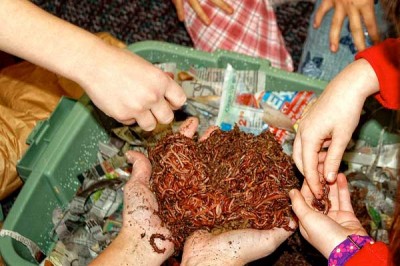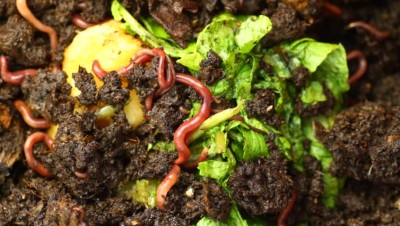Were you one of those children who loved to pick up wiggling worms after a rain? You can still play with these helpful friends as an adult gardener. Worms are actually quite the composters themselves and through the art of vermicomposting, they are helping us grow healthy, organic food.
What Is Vermicomposting?
Vermicomposting is a process of composting whereby worms of many different varieties are used to make rich compost – in this case, worm poo. Red wigglers are the most common worm used, as they eat the most and the quickest, followed by white worms and earthworms. In addition to worms, you must include healthy food scraps, moist bedding and vegetable waste. Worms don’t like extreme temperatures, so you will have to keep this in mind.
This worm and waste mixture creates a fertilizer that is natural, organic and rich with nutrients. It is a great way to compost indoors during the winter, and you can do it year-round. This type of composting can be done anywhere, even in apartments.
Why Use This Type of Composting?
Vermicomposting is quick and easy. All the worms need to do is eat and poo. It doesn’t smell, though you need to make sure you do it properly.
This New All-Natural Fertilizer Doubles Garden Production! [2]
Another reason to use vermicomposting is it is natural and creates a rich fertilizer you can use on everything. It is also very convenient as you usually will have it right at your fingertips.
How to Vermicompost
What you will need
- Container
- Bedding
- Worms
- Scraps
- Water
Steps to vermicompost:
- You can buy worms if you want a good jump start. Red wigglers are often recommended. They consume a lot more than the regular garden worms, and live in small spaces very well.
- Keep your worms and compost at room temperature. Do not let temperatures drop to below 10 Celsius or 50 Fahrenheit. Also, don’t sit your worms in hot, sunny areas, either. Keep your worms inside all year long; it is much easier this way.
- Put your compost and worm bin in an area that is easily accessible, for example: a bathroom, basement, warm garage or under the kitchen sink.
- Place a tray under your bin or container to collect any moisture or drips. You can use this moisture to fertilize any indoor or outdoor plants.
- Moist bedding is needed in the bin for your worms. Shredded newspaper, (not magazines or glossy flyers) works well. Make sure the bedding is moist, but not soggy. Worms need a layer to be covering them all the time.
- Do not pack the bedding down. It may be a surprise that not all worms are good at burrowing. At the beginning, add a handful or two of dirt, not too much. Vegetables, fruits – even used tea bags and coffee grounds as well as eggshells are good to add to compost often. Eggshells will help control acidity.
- Some food scraps should be avoided. Pineapple and papaya in particular contain an enzyme that can kill your worms. Also avoid adding too much citrus, onions and garlic which can cause the soil to become acidic and send your worms crawling up the sides of your container instead of making valuable compost.
- Collect food and “feed” your worms twice a week. Chop the food into small pieces and put it in the bin. Cover the fresh food with a thin layer of bedding. Overfeeding will attract fruit flies and cause a smell.
How To Maintain Your Worms
 [3]Feeding: Keep feeding on a routine and harvest whenever needed.
[3]Feeding: Keep feeding on a routine and harvest whenever needed.
Want The Best Chemical-Free, All-Natural Insecticide — For Your Garden AND Home? [4]
Check dirt: You must keep an eye on the moisture content of the bin, as your worms can drown if there is too much that is wet. To help with this issue, you can put holes in the bottom of your container or bin to help drainage and prevent soggy conditions. It is a good idea to check regularly, and add bedding when needed.
Use properly sized container: Containers need to be about eight to 12 inches deep; this will help the worms eat easily. If the container is plastic, do not close the lid tightly. Leave it loose when closed.
Bedding and its sources: Shredded cardboard, shredded paper, peat moss and commercial worm bedding are all good. Bedding should make up 2/3 of the container or bin. Wet the bedding with water, and squeeze it all out before adding to the container.
Acquiring worms: You can order worms from garden centers, catalogs, bait stores or even gardeners who are already vermicomposting and have a good stock. You will need about ½ to 1 pound of worms to start.
Watch the diet: While worms are omnivores, adding meat scraps is not recommended as it can attract rats and mice that will not only eat the worms, but take up residence in your home. Vegetables and plan-based scraps are best. Remember to start slowly; it takes time to build up enough bacteria for the composting.
Worms are a simple, easy and affordable way to always have compost at your fingertips. Vermicomposting is one fun way of ensuring a truly organic garden. It can be done by those of all ages, and it doesn’t matter if you are new to gardening or an old pro. The worms won’t judge.
Have your vermicomposted? What advice would you add? Share your tips in the section below:
Every Year Gardeners Make This Crazy Mistake — But You Don’t Have To. Read More Here. [5]

